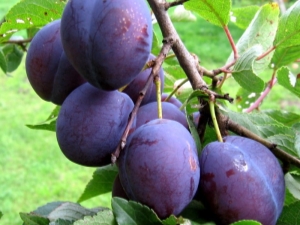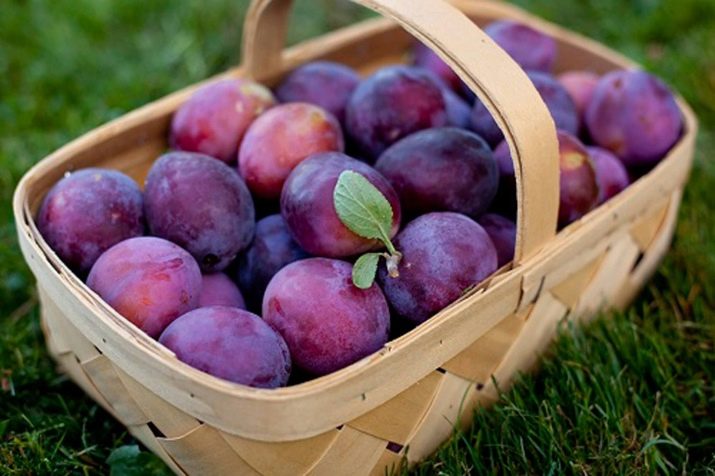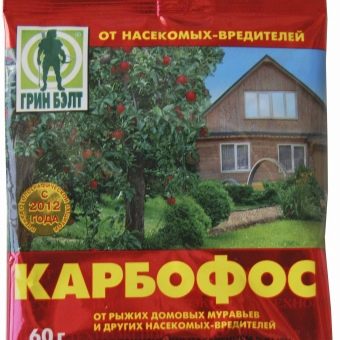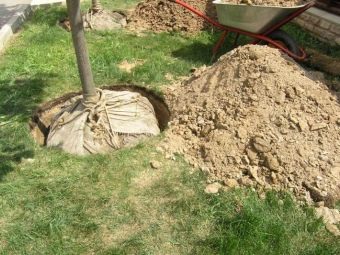Plum "Anna Shpet": characteristics, planting and care

“Anna Shpet” plum is a rather popular variety that belongs to late varieties of fruit. From about mid-October, you can savor this sweet homemade plum.The tree differs in ease in leaving, and also stable, rich fructification. Usually, the fruits of the variety “Anna Shpet” are used fresh, although they are excellent for preservation.
Short description
The variety "Anna Shpet" was obtained 80 years ago. Its founder is the famous breeder L. Shpet from Germany. Plum tree of this variety is long-lived and vigorous, it produces fruit for 30 years. Adult discharge reaches a height of 4.5-5 meters. The dense crown attracts attention with its breadth. Straight shoots are characterized by power, their color can vary from light to red-brown.
The leaf of a plant is presented in the form of the extended oval, the top is pointed. Has the average size, light green color. The trunk is strong and straight, the anthocyanically colored stalks are short. One flower includes eighteen stamens. White flowers have small oval-like petals. The cup is presented in the form of a bell. Each inflorescence includes two flowers.
The fruits of the variety "Anna Shpet" are characterized by a large size. The weight of one fruit on average reaches 45 grams. The fruit is oval in shape with a weakly abdominal suture. Purple peel is characterized by thinness and density.
Light yellow pulp is rather juicy, weakly oxidized in air. Many like the sweet-honey taste of the fruit with a slight sourness. The aroma of the fruit is strongly felt.
This variety has the following positive aspects:
- large, large fruits;
- excellent taste properties;
- a bountiful harvest;
- ease of care;
- long storage
Like many plum varieties, “Anna Shpet” has its drawbacks, including the following points:
- harvesting is quite time consuming and long process;
- fruits after ripening have a tendency to cracking;
- wood of this grade is characterized by friability.
If there is no time to collect the fruits after full ripening, they still remain on the tree without falling off. Good fruits begin to appear on the tree only in the fourth year after planting. The harvest can be stored for a long time, if you choose a cool place for this, while the plum retains all the useful qualities and taste characteristics.
Special features
Variety "Anna Shpet" is frost-resistant, because the plant is able to recover even after very severe frosts. But it should be understood that in cold climates the tree gives a bad harvest and begins to hurt with time. The plant is unpretentious when choosing the soil, as well as in the care. It easily endures a long drought. Plums can be grown even in the steppe, where it adapts to the environment and easily tolerates the absence of moisture.
In order for the plant to produce high yields, attention should be paid to pollinating trees. The following varieties can be used as pollinators for the “Anna Shpet” variety:
- "Victoria";
- Altana;
- "Greencloth green";
- "Catherine the Early";
- "Kirke";
- "Hungarian home".
Every year a tree produces a rich harvest, if weather conditions contribute. But care also plays an important role; therefore, it is very important to take care of the plant in order to obtain a bountiful harvest.
Yield
The plant can be called skoroplodny, because as early as 3-5 years after planting, the tree begins to bear fruit. Although there are cases when the first plums appear only in the sixth year. Plum of this variety is characterized by systematic fruiting with increased yield. You can pick the fruits all at once, because they are not prone to falling off and for a long time they are firmly held on the tree even in ripe form.
In general, the harvest of this variety depends on the age of the tree. So, for 10 years from one tree can be collected from 25 to 30 kg of fruit. At about 12, the plant brings an average of up to 65 kg of plums. A tree aged 13–20 years is distinguished by its highest yield, which can reach 150 kg.
Pests and diseases
The variety “Anna Shpet” does not produce an excellent harvest in cold climates, in such an environment the plant is very prone to various diseases. If a tree grows on carbonate soil, then there is a high probability of getting chlorosis and also being attacked by red fruit mites.
To protect the tree from their invasion, it should be treated with such drugs as Avant or Tagore. Processing should be carried out before flowering plants. For autumn processing is ideal tool "Malathion". In the role of prophylaxis, 3% urea solution will be an excellent solution. If a gray raid appears on the fruits of the plum “Anna Shpet” and the leaves are covered with brown spots, then most likely the tree is infected with moniliosis. If time does not take action, the leaves of the plant will soon begin to dry. For treating wood, an excellent solution would be Bordeaux liquid treatment. In addition, it will be necessary to prune diseased branches.
Usually in summer, in the season of heavy rains, red and yellow-orange spots may appear on the leaves of the tree. For the treatment of this disease is to apply a 2% solution of nitraphine. If you do not treat the tree during the destruction of its foliage, then there is a huge chance of losing all the leaves, which, in turn, will negatively affect the crop.
In order to prevent the disease of the plum “Anna Shpet”, it is imperative to collect all the fallen leaves and burn it, and in the spring you need to carefully dig the soil near the tree.
How to plant and properly care?
The ideal time for planting the plum variety “Anna Shpet” is in early spring, because during this period the land thaws completely. If an acidic soil is chosen for planting, then it must be lime. An important factor when choosing a place is the level of groundwater. They must pass below 1.5 meters.
It is better to plant plums in sunny places, but perfectly protected from drafts. An excellent solution would be the location of the tree near the wall of the house, behind the fence. It is preferable to the south side. The Anna Shpet tree grows well in loamy soil with high humidity.
After choosing a suitable place, it is worth going directly to the landing.
- It is necessary to dig a hole, the depth of which should be from 50 to 60 cm, while the diameter should vary from 70 to 80 cm. Put a planting peg into the hole, then fill it with two thirds with a special mixture consisting of soil, mineral and organic fertilizers. (2.5 kg of superphosphate and up to 15 kg of humus will be required).
- The tree should be carefully installed in the prepared hole, and then prikopat tight, but at the same time around the plant should be left hole for regular watering. For reliable fixing it should be tied to a peg. To do this, you can use a film or a soft rope. Near the plant should grow several trees pollinators.
The root neck of the seedling should not be buried in the ground, it should be located at about 5 cm above the ground.
The annual tree does not require fertilizer, but only needs careful watering. The land around the plant should be loosened and weeded from weeds. When the tree begins to bloom, you need to cut up to 80% of the flowers, which will improve the survival process. After a year, you can make the plant feeding nitrogen. Until the tree starts to produce stably crops, it should be fertilized three times a year: in May, June and August. When the tree begins to bear fruit regularly, it should be fed in the following periods:
- before it starts to bloom;
- at a time when the fruits begin to ripen;
- after harvesting the whole crop.
A solution of potassium superphosphate, nitrophosphate or urea is often used as fertilizer. It is necessary to feed the moist soil, after which it should be properly loosened. It is strictly forbidden to feed with a nitrogen content in the autumn.After each weeding, the ground around the plant should be loosened thoroughly, then it must be watered and humus added to it.
According to reviews of experienced gardeners, the variety “Anna Shpet” has a tendency to root shoots. If it is found, remove excess roots immediately.
Strong and regular watering, as well as proper cutting, are important points in tree care. When planting, the first pruning should be done, with the branches being reduced by one third of the length; further pruning is done each spring. In this case, it is necessary to remove all the diseased or frost-damaged branches.
After that, it is worth thinning the young shoots, while leaving only healthy and strong. Experts do not recommend cutting many branches in one run. No more than a fourth part of the total quantity may be removed. When a tree grows to about 2-2.5 meters, then you can begin to form its crown. Both the upper part and all vertically directed branches should be cut. If there is a strong thickening, then it is also recommended to do thinning.
Plum "Anna Shpet" - a great option for novice gardeners. It does not require complex care, but constantly pleases with abundant sweet and fragrant harvest.
You will learn more about the Anna Speth variety plums in the next video.




































